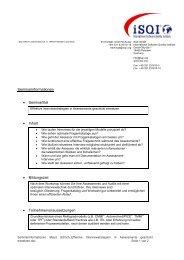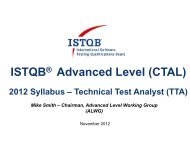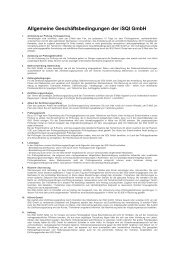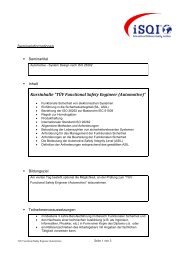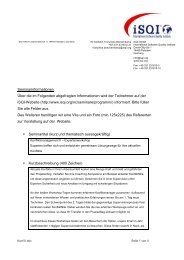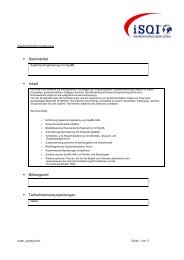conquest 2009 - iSQI
conquest 2009 - iSQI
conquest 2009 - iSQI
Create successful ePaper yourself
Turn your PDF publications into a flip-book with our unique Google optimized e-Paper software.
14<br />
Tutorial GREETING Speakers<br />
TUTORIAL I TUTORIAL II<br />
Vipul Kocher<br />
PT PureTesting Software Pvt. Ltd., INDIA<br />
“Creating Real-World Test Cases using Extension to Noun<br />
and Verb technique”<br />
This tutorial presents an Extension of Noun and Verb Technique.<br />
Most of the structured test design techniques are<br />
useful when detailed requirements are available. Even with<br />
detailed requirements, the existing test design techniques<br />
leave many holes some of which are covered by ad-hoc<br />
or exploratory testing and other experience based techniques.<br />
Extension to noun and verb technique can help create<br />
test cases even when requirements are sketchy. This<br />
technique can help create test cases of varying complexity<br />
and it also allows creation of scenario based tests.<br />
The technique has successfully been used on various projects<br />
with great results.<br />
Agenda<br />
• Challenges when requirements are missing<br />
• Limitations of existing test design techniques<br />
• Introduction to Noun and Verb technique<br />
• Extending the Noun and Verb technique<br />
• Example: Application of the technique<br />
• Exercise: Writing tests using the technique<br />
• Caveats<br />
• Conclusion<br />
Mieke Gevers<br />
AQIS bvba, BELGIUM<br />
“The foundation of Load Testing”<br />
Load & performance currently belongs to the top ten on the<br />
list of most critical aspects of a company its credibility, either<br />
towards the internal productivity or even the external<br />
visibility of the company via websites. But what does “Load<br />
& Performance” mean for the different parties during the<br />
life-cycle the application and how effective can we measure<br />
them? The most nagging questions: “How well will our<br />
servers cope with high volume of users? Did the design of<br />
our back-end architecture meet the “real world” its expectations?<br />
How our end-users and customers use our systems?”<br />
To provide founded answers instead of guessing<br />
the probable outcome of these questions, a well planned<br />
and controlled Load & Performance test is needed.<br />
This half day tutorial will get you acquainted with the used<br />
terminology and aspects of Load & Performance testing;<br />
giving you a first insight into the differed process stages<br />
needed to setup successful the load test. We will touch the<br />
aspect of information, which is requested at meetings concerning<br />
the design and architecture of a load test. Also we<br />
will talk about the ways of implementation, testing aspects<br />
& the use of measurements. Tips regarding the load test<br />
automations, how to improve setting a stage for a load test<br />
as well as an insight on what needs to be modify scripts will<br />
be provided during the sessions.<br />
TUTORIAL III<br />
Tutorial Speakers<br />
Klaus Brüggemann<br />
HOOD GmbH, GERMANY<br />
„Writing Software Requirements - Excellence is not difficult”<br />
This tutorial will change you view on requirements. We<br />
will address and analyze the typical problems of specifying<br />
requirements and we will collectively develop solutions<br />
for the problems addressed. After a short presentation of<br />
the essential quality criteria for requirements and some<br />
hands-on methods and hints for writing good requirements,<br />
the participants will analyse some requirements in groups.<br />
After discussing the analysis results, the participants will<br />
apply their new skills to improve some of the requirements. So<br />
you see this is more a tutorial with workshop characteristics.<br />
The participants are asked to bring in their individual problems<br />
with requirements and the tutorial will focus on solving<br />
these problems. Therefore the participants are asked<br />
to send their ‘problems’ to the conference organizer 2<br />
weeks in advance in advance, so that we can anonymise<br />
the requirements and select some to be used in the tutorial.<br />
15



